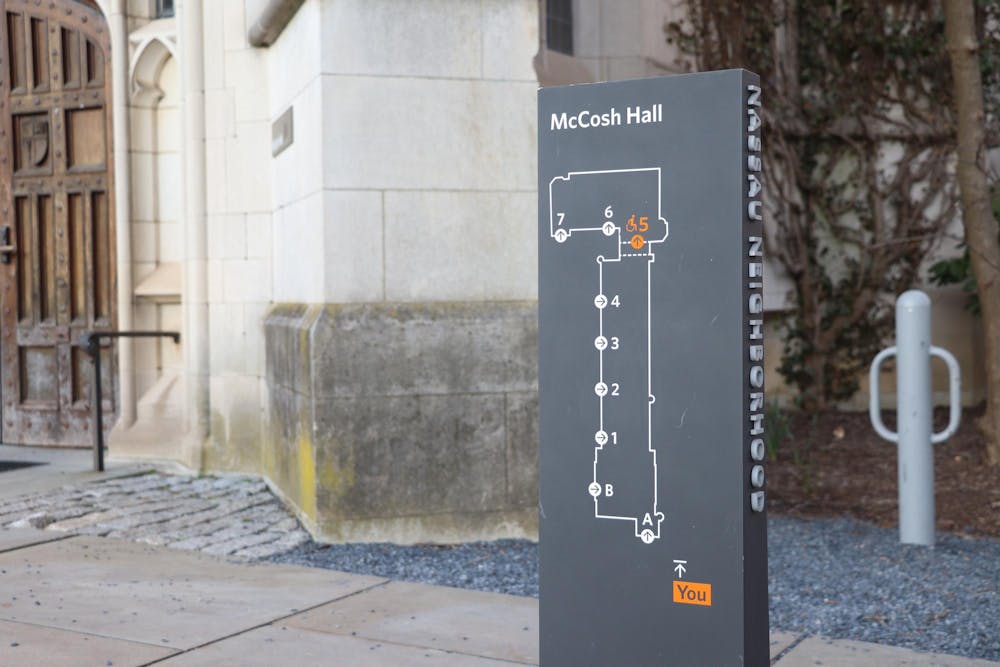This fall, Princeton became the first U.S. university to partner with AccessAble, a disability access organization that recently expanded into the United States. Princeton has launched interactive AccessAbility guides, allowing students, alumni, and visitors to see all accessible entrances, restrooms, elevators, and accessibility features in buildings campus-wide.
The website additionally highlights its accessibility symbols guide with 39 features that detail the specifics of accessibility for all students on campus. These symbols denote a variety of accessibility features — ranging from automatic door markings to braille signage to step-free restroom locations. Users can search for specific buildings for location-specific information. For instance, a symbol of two rectangles with outward-facing arrows signifies that there are “automatic or no doors at entrance” and the outline of a harnessed dog signifies the presence of “facilities for service animals.”
University Young Alumni Trustee Naomi Hess ’22, who uses a wheelchair, said that the changes were much needed. Before the implementation of the map and guide, Hess and other students have described significant challenges accessing significant buildings around campus.
Describing her first experience accessing the Rocky-Mathey Dining Hall via wheelchair, Hess noted circling the courtyard for 20 minutes because she could not find the sole accessible entrance.
“It shouldn’t be that hard to find an entrance to a building,” Hess said in an interview with The Daily Princetonian.
Princeton’s inaugural director of accessibility, Mike Barnes, shared to the ‘Prince’ that “the guides provide details about spaces like the width of doorways, accessible restroom features, and turning radiuses in elevators that are essential to those with disabilities. This information is available in a searchable, navigable way that allows those with disabilities to have the details they need at their fingertips.”
Most of the guides are also viewable through the Facilities Campus Maps on Princeton’s website by selecting the “Accessibility Guides” filter on the left side menu.
After the map and guide’s release, Hess expressed that she feels much more optimistic Princeton’s accessibility.

“Any feature you can think of that matters to people with disabilities, Princeton includes,” she told the ‘Prince.’ “You don’t have to find out this information anymore; you don’t have to circle around buildings to get in. It’s one less thing that disabled people have to worry about.”
Hess is an associate News editor emerita for the ‘Prince.’
To some, however, Princeton still has a ways to go in terms of accessibility around campus.
“I think it’s really great that Princeton has made the information about campus accessibility public because that’s the first step in creating space for where people can demand further improvements,” Katie Horan ’25 said.

“I just don’t think it’s enough. I think there is more work that needs to be done for Princeton to be a place that’s accessible for all people.” Horan is the lead coordinator of an initiative called All Bodies All Brides, which works to “make the bridal industry accessible to people with different types of disabilities.”
Horan noted that places without stair-free entrances are still not physically accessible to all those who need to enter those spaces. She also emphasized how accessibility expands beyond just physical aspects — for example, she emphasized “what sorts of lighting options there are in a space, because light can be really overstimulating for certain people.” Horan added her hopes for the University to continue addressing accessibility needs and to address sensitivities regarding noise, touch, and other sensory stimuli.
Director of Disability Services Asha Nambiar outlined how, together, the map and guide are “a key representation of the AccessAbility Center’s mission to ensure that everyone in the Princeton community has equal access to campus spaces, resources, and opportunities.”
She also mentioned how these additional resources play “a critical role in promoting inclusivity by addressing a primary need for students, faculty, staff, and visitors with disabilities: navigating the physical campus independently and with confidence.”
New construction projects such as the 1986 Fitness and Wellness Center and Prospect House have focused on accessibility improvements. As a result, both buildings now have full access to all floors via elevator.
Although some Princeton buildings are not yet included in the released guide, Niambar emphasized the significance of the changes that have been made thus far. “More than simply meeting accessibility requirements, the map empowers individuals by providing the information they need to plan their routes, anticipate potential barriers, and make informed choices about how to best access facilities,” she noted.
Isaac Bernstein is a News contributor for the ‘Prince.’
Victoria Davies is an assistant News editor for the ‘Prince’ who covers University operations.
Please send any corrections to corrections[at]dailyprincetonian.com.








